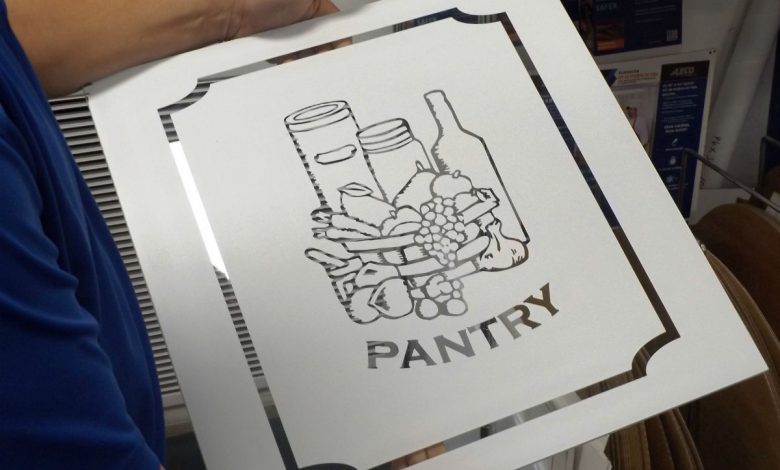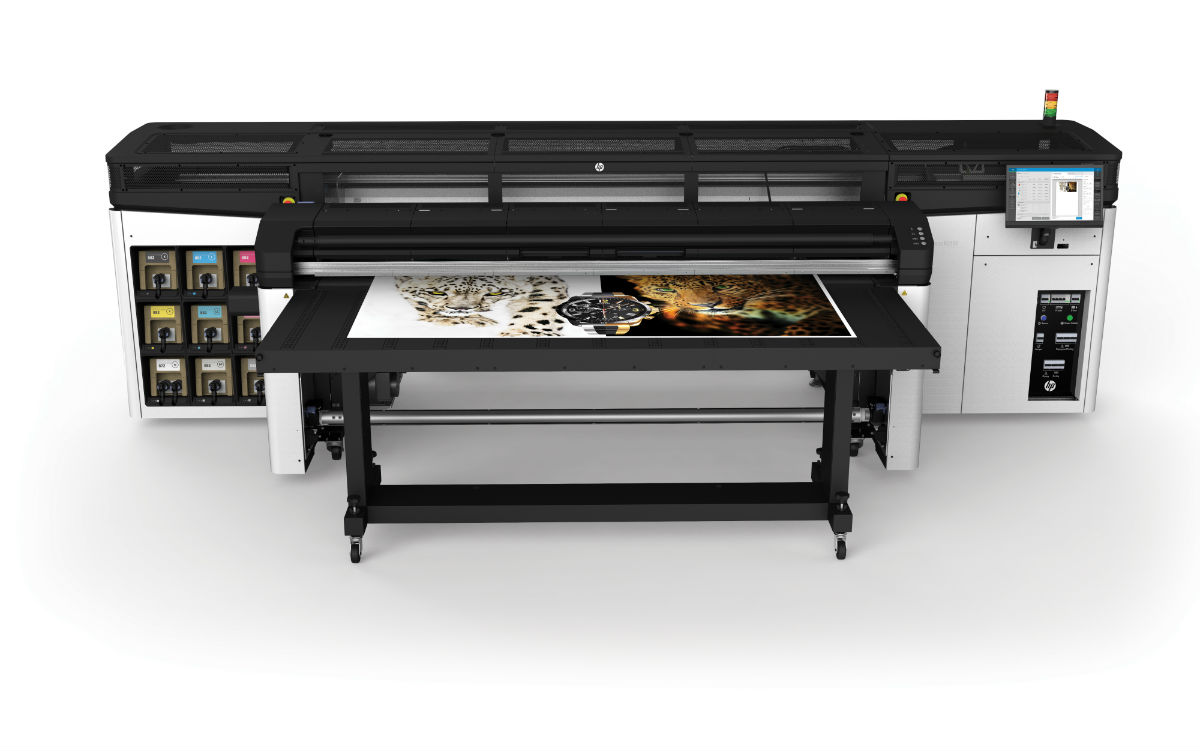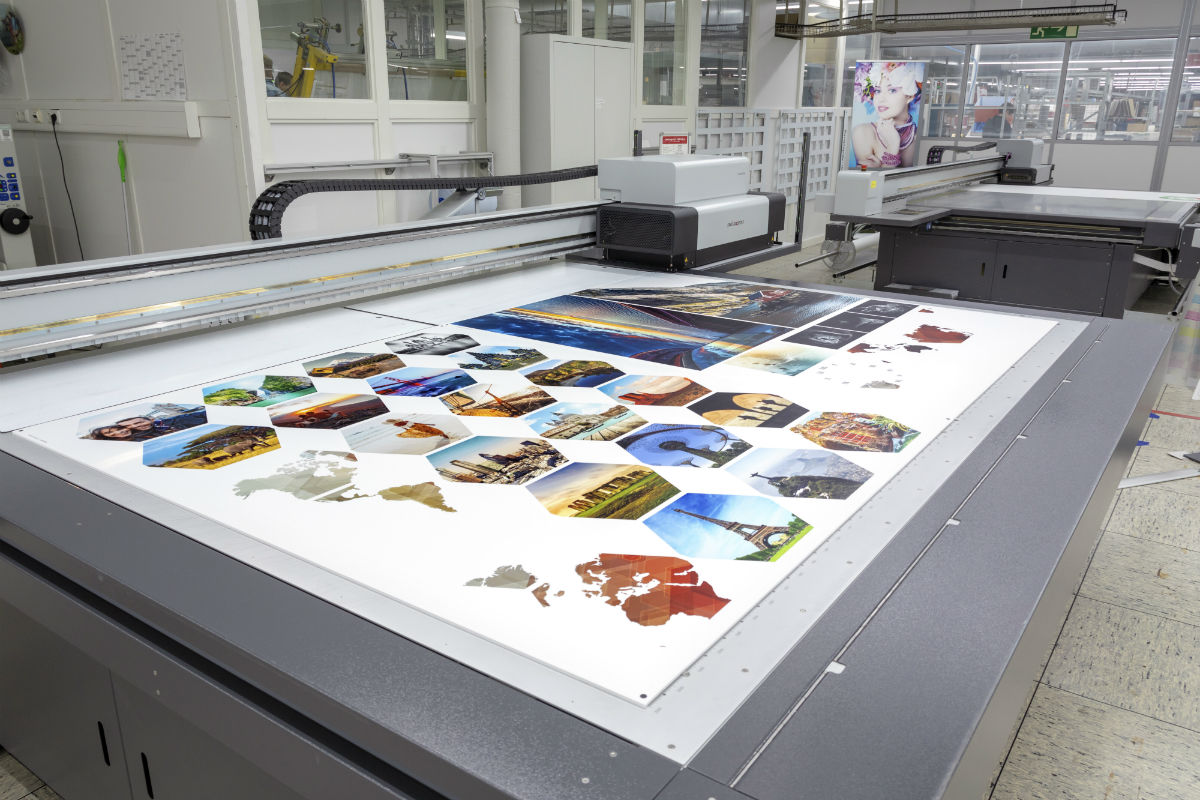High-Production Flatbed Printers
Flatbed technology continues to change the landscape of the high-production printing market.
The latest crop of high-production flatbed printers continues to push the envelope and provide shops with a plethora of opportunities. Over the past decade, the use of flatbeds in the wide-format sector has grown tremendously. During that time, flatbed printers’ improved speed, automation and flexibility have allowed shops to raise production levels as well as offer new applications for clients. In addition, the growth in more economical hybrid units that are capable of printing both flat substrates and roll-to-roll have allowed smaller shops to enter this area. Today’s flatbed printer market is packed with a host of output options, which is good news for output providers looking to increase their productivity. Let’s look at the recent gains in speed and productivity of flatbeds and give an overview of how far this booming market has come in a short period of time.
Speed and Versatility
Thomas Krumm, product marketing manager, EFI Inkjet Solutions, Meredith, New Hampshire, is seeing a number of growing trends in this area.
“There is a lot of demand for speed and for versatility. Display graphics producers are often looking to consolidate work that they may do on several slower devices, plus they want the efficacies they can gain in moving jobs from screen printing to digital or lowering the number of steps it takes to complete a job.”
He notes that speed is always important, but shops also have different productivity needs. “Those needs have driven a lot of the interest in our VUTEk h3 printer. It is a high-end, 126-inch-wide hybrid device that prints up to 74 boards per hour and one of the critical things about it for our customers is that it can be upgraded in the field to an h5 model, which runs up to 109 boards per hour. For printers to run at these speeds, minimizing the non-print time is critical. If a printer can print a board in 30 seconds but it has 30 seconds between boards, you cut your speed in half.”
Latex Changes the Rules
Thomas Giglio, business development manager at HP, Belvidere, Illinois, believes that the introduction of Latex flatbed printing has turned out to be the biggest disruption to the flatbed industry since Océ launched the Arizona variable drop printer in 2005. “Overall, the industry is seeing better image quality at sellable production speeds. Additionally, newer platforms are greatly expanding the application range and substrate compatibility.”
He adds that recent gains in the speed and productivity of flatbeds have been good news for output providers.
“More applications that have traditionally been printed using other means (litho, flexo, screen printing) are being moved over to digital flatbed printers because of their increased agility, image quality, application range and ability to deliver in tighter deadlines. Versioning and customization have also driven more work to higher-production flatbed platforms.”
Automation is Huge
Becky McConnell, product marketing manager, Fujifilm North America Corp., Graphics Systems Division, Hanover Park, Illinois, says that one of the big trends she is seeing in today’s high-production printers is in automation. “I know automation has been very popular in recent years from a media-handling standpoint, but we see more and more automation throughout the entire production process with the use of software and mechanical technology. Print service providers are constantly looking for ways to be more productive and increase throughput, and sometimes just shaving a small portion of time from a process has major benefits because of what that saved small portion of time means in the long run.”
She adds that another trend she is seeing is PSPs expanding to serve more markets to help drive top and bottom line success for their business.
“PSPs have the opportunity to seek out additional work from existing clients, beyond seeking new clients, often without having to make printer upgrades or major operational changes,” McConnell says. “With a strong mix of application potential, it’s easier to never tell a client or prospect ‘no.'”
McConnell explains that speed and throughput are, and will remain, critical for print service providers so recent gains are important. “It’s also important that suppliers continue to push the limit with speed and output potential for high-production flatbeds. With speed and throughout advancements, it allows for digital wide-format opportunities to continue to grow. It continues to move the needle and realign the print quantities that are economically feasible with digital versus analog printing processes.”
More Applications
McConnell points out that with a flatbed’s ability to manage printing thick, rigid sheets, and with accurate registration, flatbed printing has allowed for print service providers to expand beyond their typical applications they offer their clients.
“Advancements in flatbed printing technology have enabled flatbed printers to be more productive, even if not by increasing speed, but perhaps allowing for automated handling systems or other automated features,” McConnell says. “With technology allowing for a print-quality output level that clients are satisfied with, high-speed flatbeds have given print service providers the opportunity to move more work to digital and seek clients in new markets with new demands.”
Keeping Media in its Place
McConnell says that when it comes to media handling, a flatbed features either a moving print bed or a moving gantry that keeps the media in one position while the printer is jetting ink; the only difference between the two is if the gantry is moving or not. Because the media on a printer with a vacuum table is held in position, the media handling would have more to do with an automated handling system versus the printer itself. When it comes to a belt-driven device, the ability for media to track properly has everything to do with the straightness and stability of the belt/roller system. “It’s critical for PSPs to evaluate the effectiveness of media handling based on their needs when considering a new investment or upgrade to their current operations.”
McConnell says when looking at hybrid versus dedicated flatbed models, the benefits are personal preferences, and depending on which route a print service provider takes, typically has a lot to do with their past success and the limitations they face. “Benefits of a flatbed include registration because the substrate is not moving like it is on a belt-driven device-however, there are flatbeds with roll systems that allow PSPs to accomplish both rigid and roll printing with one device. When it comes to hybrids, from a space and capacity standpoint, shops with limited space can benefit from such a device. On the other hand, depending on how a shop handles their workflow and production operations, hybrid devices do give PSPs the flexibility to print both flexible and rigid material on the same machine, which allows them to be more flexible in their job planning and assigning.”
Rolling With the Changes
McConnell says for them, the sign and display market was the first to adapt to the changes with the wide-format inkjet, and thinks that had to do with demand. “PSPs saw the market changing and run lengths were changing; screen printers needed a solution to answer to custom or regional designs, and the quality expectations allowed that change to start to take place with digital wide format. Since then a number of other markets have seen such changes, and with advancements in printing technology, other markets/applications have been able to migrate, at least partially, to digital printing. A good example of that is the corrugated market, and their need for a digital solution grows across the industry, and that can be with the various multi- and single-pass machines that have been developed and introduced to service corrugators and converters.”
Onset X3 Users Stand Out
McConnell says that technology developments in the flatbed market have been real game changers for many of their end users, such as Direct Edge Media and Southern Carton.
“Our customers expect perfection,” reports Ryan Brueckner, CEO of Direct Edge Media, a full-service facility in Anaheim, California. “We chose the Onset X3 for its speed, quality and color gamut.”
“With the Onset X3, we have the ability to produce jobs quicker, and at a higher volume,” adds Nick Oshiro, vice president of operations at Direct Edge Media. “We decided to have two white ink channels to produce more jobs in-house. The Onset X3 helps us stand out purely due to the speed and quality.”
Southern Carton runs many types of projects on their Onset X3. “We are printing on glass, and a lot of acrylics,” notes Eugene Peek, digital coordinator, Southern Carton, who specializes in packaging and is based in Lewisburg, Tennessee. “With the speed and flexibility of the Onset X3, we are able to accept many new jobs and turn them around same day, or within 24 hours,” Peek adds.
Blazing Speed from swissQprint
Mike Kyritsi, president, swissQprint America, Elgin Illinois, says the speed models (Nyala 3S and Impala 3S) the company rolled out last year are good examples of suppliers helping meet high productivity needs that shops require in today’s market. “These printers combine quality and speed in a unique way. The user achieves elevated output rates on an excellent quality level, which, in turn, boosts the printer’s ROI. After all, customers are prepared to pay for quality work. If that can be completed in a short time, the PSP will obviously profit.”
He explains that in today’s market, in many cases a 24-hour-turnaround time is required for even standard applications. That has become the norm. “Reliability is as important as productivity. In addition, printers need to be energy-efficient to contribute toward total cost of ownership and sustainability.”
Kyritsi notes swissQprint machines have an outstanding and certified energy efficiency according to ISO standard 20690:2018. He says that flatbed printers offer the largest variety of application possibilities compared to any other printer type. “That variety may even be extended if the printer offers add-ons such as a roll-to-roll option or white and varnish printing. The good thing is that the PSP only invests in one single machine rather than several specific ones, saving money and production space. In addition, consistency will be much easier to achieve if, for instance, campaigns comprising different items are produced on one and the same printer. Overall, given their design (no feeding), flatbed printers offer the highest precision and the best printing quality.”
He adds that swissQprint units feature a unique registration pin system, enabling precise double-sided printing. “There is even a Flip functionality to print mirrored double-sided images easily and with 100% accuracy.”
Hybrid Vs. True Flatbed?
Kyritsi says that the hybrid versus the true flatbed debate can be best answered by what type of job the PSP will typically be able to handle. “Generally speaking, both types of equipment are capable of doing standard applications. However, hybrids are much more suited to doing longer runs of the same material while true flatbeds are more nimble and are the right tool if you need to change from one media or size to another very quickly and/or if jobs are complex (multilayer/ double-sided etc.). In other words, if a PSP had to print 200 4 x 8’s a shift every day, they would probably look at a hybrid with automation. If they had to print 100 totally different jobs every day and would like to offer special applications, they would much rather opt for a true flatbed,” he concludes.
A Sharper Image
HP’s Giglio notes that there have been many advances in image quality that make flatbed printers more relevant for more applications. “Corrugated packaging, for example, is one of the leading opportunities for flatbed owners because of the image quality. The capacity and productivity improvements have also enabled flatbed printing to be a viable alternative to traditional analog printing.”
He says they tend to find that rather than size of the PSP, there are other factors that are more application-centric that will ultimately make the determination on which type of printer to purchase. “Usually that decision process will evolve around overall image quality, form factor of substrates and other factors like color gamut, ink adhesion and white ink management.”
Giglio adds that corrugated, packaging, wall décor and sustainable products are some of the top current applications.
He reports that one of their end-users reaping the benefits of current flatbed technology is KalBlue, a print solutions provider in Kalamazoo, Michigan. The company has in its printer arsenal the HP Latex R1000 printer. “The R1000 has allowed us to produce quality projects that we could never produce in-house before. It has enabled us to generate more projects with the higher image quality that our customers are demanding,” says Kip Young, president and chief executive officer at KalBlue.
Choosing the Best Solution
EFI’s Krumm notes that various machines differ in terms of media handling. “All these designs have their advantages and disadvantages. The key is to know what they are and to choose the best solution for your application range. For instance, a moving gantry design you can print on one side of the table while you are loading on the other side of the table if your typical work is on smaller boards. This can’t be done if you have a flying table design but does not matter if most of your work is on full-size boards. That’s where the advantages of a hybrid come in. It does not matter if they are large boards or small; you can maximize your productivity with the minimum amount of time between boards.”
Hybrids Offer More Options
Krumm notes when looking at new models that hybrid technology has evolved to the point where it is the choice for a very broad swath of the industry, especially in higher-volume work. “There are some applications such as lenticular printing, that can benefit from a true-flatbed production on products such as EFI’s Pro 24f printer. But certainly, in the higher-volume production end of the market, our customers tell us products like the EFI VUTEk h series or the VUTEk HS 125 Pro printer deliver the types of speeds and efficiencies they need to grow their business on rigid-substrate or R2R work.”
He adds that the application range is very wide and varies in complexity and quality. “Once again, that is one of the main advantages for the hybrid printer but here are some of them: indoor and outdoor signage, P.O.P. advertising, exhibition graphics, backlit displays, display graphics, posters, long term outdoor graphics, banners and signage, wall murals and free-standing displays (corrugated).”
Thinking Inside the Box
Krumm says that Premium Color Group is meeting surging demand for new business and its custom packaging line using high-end LED digital inkjet technology from EFI. The Carlstadt, New Jersey-based company has installed an EFI VUTEk LX3 Pro hybrid flatbed/roll-to-roll LED inkjet printer that will significantly increase the company’s responsiveness and capabilities supporting PCG’s growing business.
The 126-inch-wide digital printer, which produces up to 50 boards per hour in its premium quality/point-of-purchase modes, offers a dramatic speed increase for PCG, so much so that the company was able to replace a pair of smaller LED printers while increasing its throughput capacity by 78%. Because the VUTEk LX3 Pro handles both rigid and roll materials, the company has also eliminated the need for one of its two roll-to-roll printers.
“Two and a half years ago, we got into the custom packaging business with our U.S.-patented box line,” explains Mark Fitzgerald, one of the three managing partners at PCG along with John Watson and Andy Griffin. “In two-and-a-half years, we grew the line tenfold, and the demand continues to grow. We needed to vastly increase our throughput while keeping the same great quality, and the VUTEk LX3 with the Fiery controller fits the bill perfectly. We loved the quality of our previous EFI printers, so we had confidence the VUTEk LX3 Pro would also be a quality product, and it is.”




